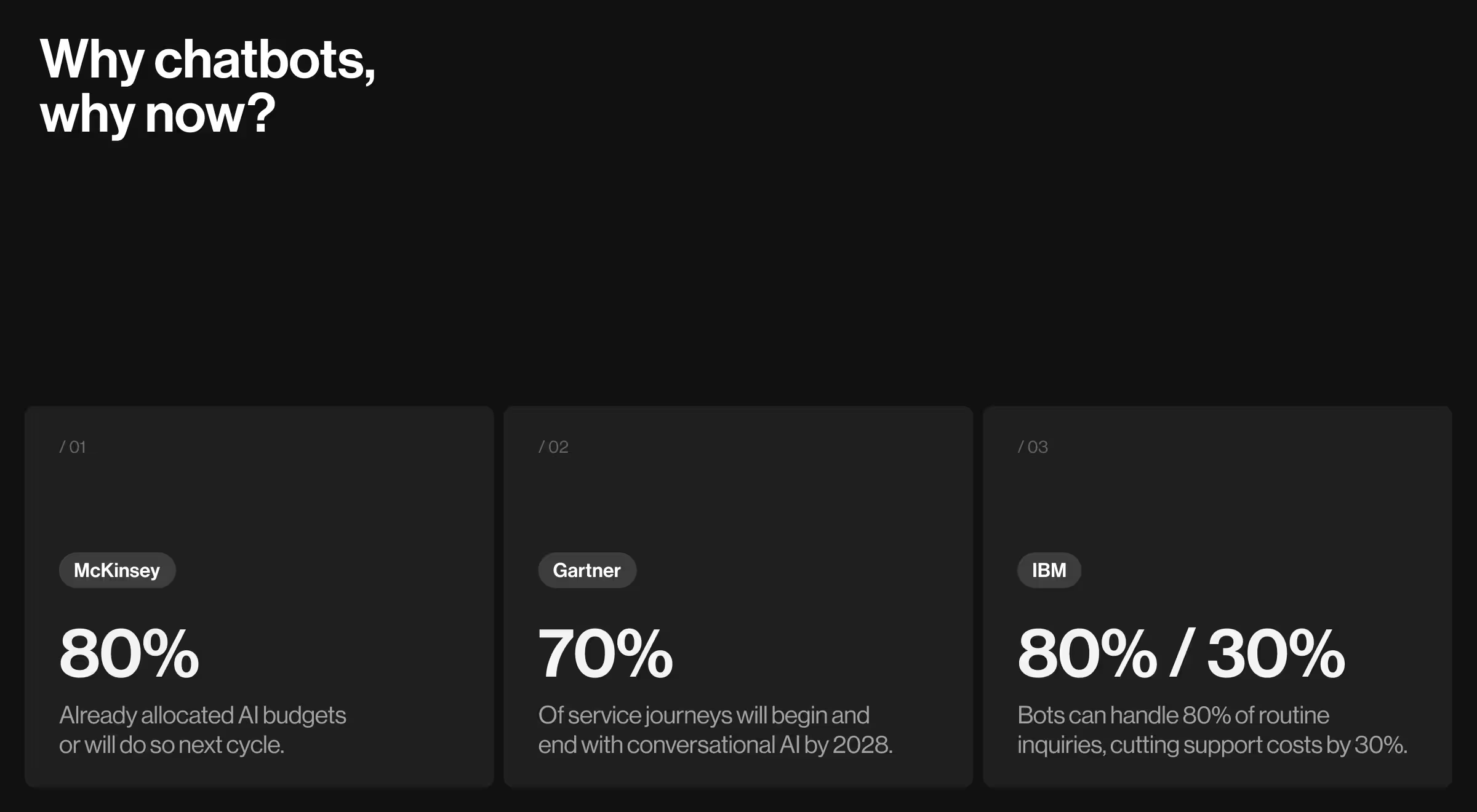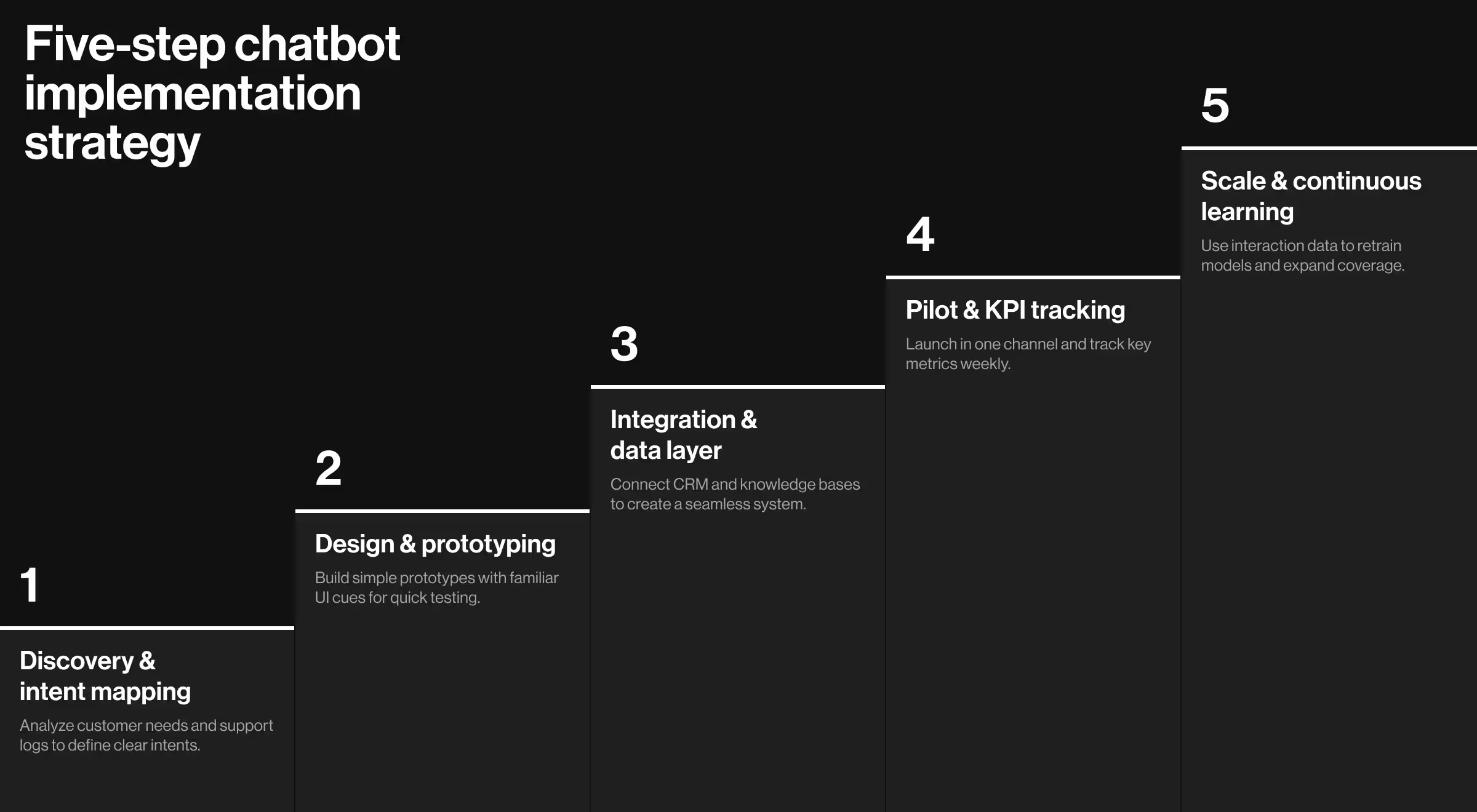A father of two opens his banking app at 2:07 a.m. to dispute a double charge on diapers. Instead of the usual “Our agents start at 9 a.m.” banner, a chat bubble greets him by name, pulls the transaction, and confirms the refund in under 90 seconds. He goes back to sleep; the bank quietly saves a ticket, a callback, and a smudge on its Net Promoter Score.
That tiny, silent victory captures why chatbot digital transformation has become a board‑level mandate. When conversation speed matches human urgency 24/7, businesses shrink support costs, unlock upsell windows, and turn sleepless annoyance into brand equity. That’s why forward‑looking teams treat AI‑powered chatbots as core infrastructure.
Next, we’ll unpack how to get there: a readiness checklist, a five‑step rollout framework, and the metrics that prove your bot is more than a cost‑cutting script.
Key takeaways
- Chatbot digital transformation turns every customer interaction into an always‑on, data‑rich dialogue, shifting speed and personalization from cost center to growth lever.
- Bots succeed when treated as a core knowledge management system.
- A disciplined five‑step chatbot implementation strategy (intent mapping, prototyping, integration, KPI pilot, and continuous learning) keeps automation useful, compliant, and adaptable.
- Real‑world results prove the upside: Klarna’s AI assistant resolves queries in under 2 minutes, replaces the output of 700 human agents, and reduces repeat tickets by 25%.
Why chatbots now?
Customers these days expect answers in their preferred channels: web chat, messaging apps, or social media. Every extra tap increases wait times and erodes customer satisfaction — that's where conversational AI steps in.
McKinsey finds that more than 80% of customer‑care leaders have already allocated budgets for AI or will do so in the next cycle. Gartner projects that 70% of service journeys will begin and end with conversational AI by 2028, while IBM reports that bots can shoulder up to 80% of routine inquiries, cutting support spend by 30%.

Conversational AI addresses three executive‑level goals:
- Improve customer service → instant, personalized replies across time zones.
- Reduce operational costs → one chatbot handles repetitive tasks that once consumed entire call centers.
- Increase productivity → human agents focus on complex cases, boosting operational efficiency.
Readiness checklist – are you built for bots?
A clear checklist prevents stalled projects and accelerates true conversational AI transformation.
✅ Pro tip: Integrate your bot into Slack, Teams, or other digital workplace tools, so employees retrieve relevant information without context‑switching.
Five‑step chatbot implementation strategy
A disciplined rollout follows the full chatbot lifecycle from pinpointing real user intents to retraining models after launch, distilled into 5 concrete steps:
- Discovery & intent mapping. Interview customers, mine tickets, and feed the log into natural language processing pipelines.
- Design & prototyping. Use familiar patterns like quick‑reply chips, progress bars, bold typography to give instant visual cues.
- Integration & data layer. Sync CRM, order systems, and knowledge management systems; seamless integration turns simple bots into profit engines. Done well, this phase reveals hidden chatbot automation benefits such as dynamic upsells and lower wait times.
- Pilot & KPI tracking. Launch in one channel, measure customer engagement and containment weekly.
- Scale & continuous learning. Apply machine learning to past interactions; retrain when KPIs flatten.

Showcase: Klarna’s AI assistant
Klarna publicly shared the KPI shifts below after launching its AI assistant, offering a concrete benchmark for enterprise‑level chatbot performance:
It’s one of the strongest chatbot transformation examples on record, illustrating enterprise‑scale gains. Klarna’s AI chatbot handles 2.3 million chats across 35 languages, demonstrating how virtual assistants combine automation and customer experience earnings.
Beyond support — enterprise‑wide AI chatbot use cases
Chatbots deliver value far past customer service tickets; once integrated with core data sources, they become operational efficiency levers across the entire digital workplace:
These use‑cases illustrate how chatbot digital transformation extends automation to every department, reducing operational costs while improving the employee and customer experience.
Metrics that matter
Track the four signals below which map directly to cost, speed, and loyalty, and set alert thresholds for dips to trigger quick course‑corrections.
These KPIs separate pilots from full enterprise chatbot solutions with board‑level visibility. Review them weekly, automate alerts when thresholds slip, and feed failure transcripts into your continuous‑learning loop.
Pitfalls & how to avoid them
Even the best rollout derails when small oversights snowball; the pitfalls below surface most often in post‑launch autopsies, and the fix is almost always procedural.
Three‑year roadmap to conversational AI at scale
Follow the roadmap to turn a pilot into a full business transformation with AI and elevate AI chatbot customer service across touchpoints.
🔍 To explore AI UX patterns for digital products, read our article or explore AI‑driven UX case study (Rhea), a blueprint for combining artificial intelligence with human‑centric design.
Turn conversational AI into your next profit center
A strategic chatbot digital transformation can reduce operational costs, elevate customer satisfaction, and let your teams tackle higher‑value work. Follow the readiness checklist, roll out the five‑step process, and track the metrics that prove ROI.
Ready to benchmark your conversational UX?
Let’s talk! Our AI consulting services map friction points and deliver a prioritized roadmap that turns automation into a competitive edge.



























.webp)














.avif)
.avif)
.avif)
.avif)
.avif)
.avif)
.avif)